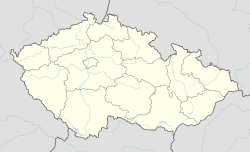Church of Our Lady before Týn
This article relies largely or entirely on a single source. (September 2015) |
This article includes a list of references, related reading, or external links, but its sources remain unclear because it lacks inline citations. (September 2015) |
| Church of Our Lady before Týn | |
|---|---|
| Parish Church of the Mother of God before Týn | |
Kostel Matky Boží před Týnem | |
 Church of Our Lady before Týn, from Old Town Square | |
| Location | Prague |
| Country | Czech Republic |
| Denomination | Roman Catholic |
| Website | Website of the Church |
| History | |
| Status | Active |
| Founded | 14th century |
| Architecture | |
| Functional status | Parish Church |
| Architectural type | Church |
| Style | Gothic |
| Specifications | |
| Number of spires | 2 |
| Spire height | 80 metres (260 ft) |
| Administration | |
| Archdiocese | Prague |
| Clergy | |
| Archbishop | Dominik Duka |
| Pastor(s) | Vladimír Kelnar |
The Church of Mother of God before Týn (in Czech Kostel Matky Boží před Týnem, also Týnský chrám (Týn Church) or just Týn), often translated as Church of Our Lady before Týn, is a dominant feature of the Old Town of Prague, Czech Republic, and has been the main church of this part of the city since the 14th century. The church's towers are 80 m high and topped by four small spires.

History
In the 11th century, this area was occupied by a Romanesque church, which was built there for foreign merchants coming to the nearby Týn Courtyard.[1] Later it was replaced by an early Gothic Church of Our Lady before Týn in 1256. Construction of the present church began in the 14th century in the late Gothic style under the influence of Matthias of Arras and later Peter Parler. By the beginning of the 15th century, construction was almost complete; only the towers, the gable and roof were missing. The church was controlled by Hussites for two centuries, including John of Rokycan, future archbishop of Prague, who became the church's vicar in 1427. The roof was completed in the 1450s, while the gable and northern tower were completed shortly thereafter during the reign of George of Poděbrady (1453–1471). His sculpture was placed on the gable, below a huge golden chalice, the symbol of the Hussites. The southern tower was not completed until 1511, under architect Matěj Rejsek.

After the lost Battle of White Mountain (1620) began the era of harsh recatholicisation (part of the Counter-Reformation). Consequently, the sculptures of "heretic king" George of Poděbrady and the chalice were removed in 1626 and replaced by a sculpture of the Virgin Mary, with a giant halo made from by melting down the chalice. In 1679 the church was struck by lightning, and the subsequent fire heavily damaged the old vault, which was later replaced by a lower baroque vault.
Renovation works carried out in 1876–1895 were later reversed during extensive exterior renovation works in the years 1973–1995. Interior renovation is still in progress.
Design

The northern portal is a wonderful example of Gothic sculpture from the Parler workshop, with a relief depicting the Crucifixion. The main entrance is located on the church's western face, through a narrow passage between the houses in front of the church.
The early baroque altarpiece has paintings by Karel Škréta from around 1649. The oldest pipe organ in Prague stands inside this church. The organ was built in 1673 by Heinrich Mundt and is one of the most representative 17th-century organs in Europe.

